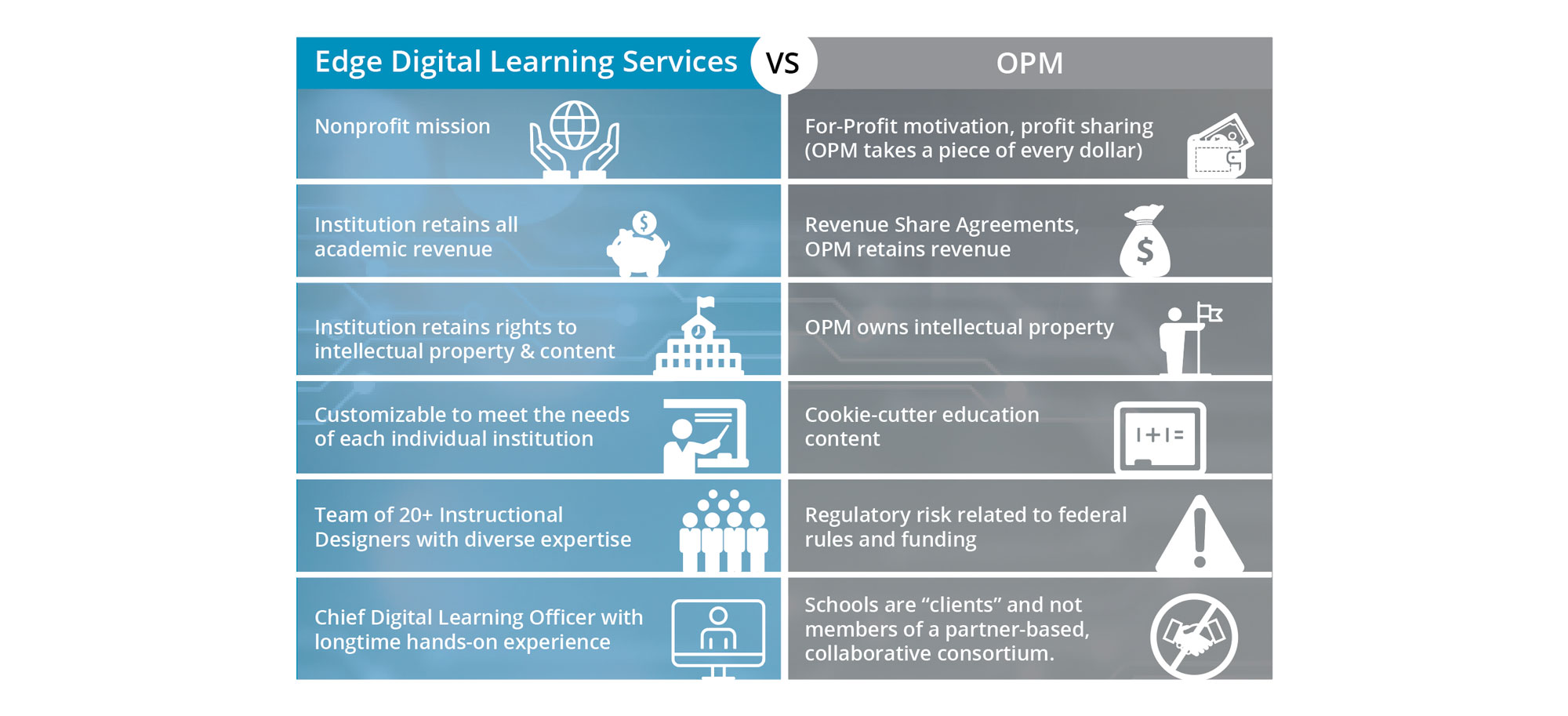How Institutions Can Take the Lead on their Digital Education Future
Long before remote learning became part of the norm amid the higher education community, many institutions were seeking solutions to expand their digital education capabilities. For several years, Online Program Managers (OPMs) have provided a suite of services, including course design and technology solutions, marketing and enrollment services, and academic coaching. This industry has grown substantially since the early 2000’s and quickly expanded during the pandemic when colleges and universities needed to bring their courses and services online quickly. Unfortunately, the digital learning options provided by OPMs are often costly and cannot be customized to meet the unique needs of each institution. Plus, many organizations have made investments in their own digital learning capabilities in recent years and no longer wish to outsource their online program management. Add in tightening federal guidelines and regulations on OPM providers, and we are seeing greater opportunities to foster successful home-grown digital learning programs.
Origin and Growth of OPMs
Outsourcing online program management and recruitment to OPMs often does not require upfront costs, but their educational and backend services are in exchange for 40-60 percent of student tuition payments. “The U.S. law bars colleges that receive financial aid from giving incentive-based compensation, which includes commissions or bonuses to companies or employees that recruit and enroll students into their programs,” explains Edge Chief Digital Learning Officer, Josh Gaul. “The Education Department considers tuition sharing to be incentive compensation, however, agency guidance released in 2011 allows OPMs that provide recruiting services to have such arrangements with colleges if they meet certain criteria. Without this loophole, OPMs would have a hard time existing at the current way they are built.”
In addition to the services they provide, many OPMs offer the upfront capital necessary to launch an online program. “After the OPM has built the program and an institution begins receiving student enrollments, they will take a percentage of those dollars as part of a revenue sharing agreement,” says Gaul. “In the beginning stages, OPMs faced the uphill battle of providing online students with services on par with what they receive on campus, so they had several risks to consider. Twenty years ago, launching an online program was expensive, with all the instructional, technology, and marketing costs associated with this endeavor. From an educational standpoint, many institutions were also concerned if the online education program would be on par with a traditional campus experience. In addition, an online program raised a host of operational questions and concerns. How is this program managed? How does it compare with in-person classes? For faculty that teach online, do they get paid the same amount for teaching in person? How does load look for faculty in terms of teaching online courses versus in-person courses? How does IT manage online programs versus in-person classroom digital technology?”
When online programs were beginning to expand in the early 2000’s, many institutions were also concerned of how this would affect their reputation. “Many people perceived online education as second rate,” says Gaul. “There was a worry that key constituencies, alumni, foundations, and hiring corporations would see an entry into the online world as a symptom of institutional weakness. Thankfully, these unknowns are not as mysterious today. While the OPM pitch was appealing over two decades ago, they have become a larger part of the problem, rather than the solution.”
“Edge does not take a dollar from your tuition and all intellectual property and content that we create in collaboration with you is yours to keep, reuse, and repurpose however you want to in the future. Many institutions have similar needs, but we can customize your solutions based on your organization’s culture and unique processes, and our goal is to provide the services you need at as low a cost as possible. OPMs will continue to face regulatory risk and evolving federal rules, while Edge, being a non-profit organization, is solely focused on serving the needs of its member institutions.”
– Josh Gaul
Associate Vice President & Chief Digital Learning Officer
Edge

Drawbacks of OPMs
Using an OPM partner can offer benefits, but with the evolution of the online education space, the challenges have begun to outweigh the advantages. “The cost of technology and services to build and run an impressive online program have dropped, but OPMs still expect schools to part with a huge percentage of their tuition,” explains Gaul. “High tuition is a critical problem in higher education and OPMs are adding to this issue. If you work with a traditional OPM, your students will pay $20,000 to $40,000 in loan repayments just to cover its profit. This is becoming increasingly hard to justify imposing that burden on your students and that cost locks you into a long-term competitive disadvantage and could cause your rankings to potentially drop.”
“Schools that find ways to go online at lower costs will be able to reduce their tuition costs and invest more in compelling programs and great staff and faculty,” continues Gaul. “Typically, an OPM’s contract with a college or university allows it to continue sharing tuition revenue for several years, even after the relationship ends. These long-term restrictive contracts can be very difficult to terminate and can extend between five and ten years with limited remediation options for institutions if enrollment objectives are not met. Many traditional OPMs also operate in a silo, so when they build an online program, they are not incorporating input and involvement from faculty and other departments. Instead of moving towards a more agile future, the OPM structure reinforces rigidity and does not support the high-flex models that are becoming increasingly popular among current and prospective students.”
Among the drawbacks of outsourcing an online program management to an OPM is the increased risk. “A traditional OPM invests its marketing dollars where it can make the greatest return, typically the programs are the least selective and most expensive,” says Gaul. “If an OPM discovers they can steer a student elsewhere with less expense or more revenue, your enrollment can suffer. Given that online programs are increasingly core to institutional missions, working with an OPM can mean adding an existential risk. A more subtle risk is when a traditional OPM represents schools in different parts of the country and will steer students in each region to their nearest client. This cuts the OPM’s marketing costs, while making it impossible for you to grow your school’s reach geographically or demographically.”
Due to the nature of revenue sharing contracts, there is no incentive to share the OPM’s strategies and data, particularly in marketing admissions. “There is a complete lack of transparency around what tactics are driving performance,” says Gaul. “This prevents a school from learning the operational analytical nuances of operating at scale and understanding why certain decisions are made and what is effectively attracting students to the institution. In addition, OPMs typically focus their efforts on the specific programmatic offerings with the highest profit margin and are highly selective in what they’re willing to support—which often does not align with an institution’s mission and individual needs. OPMs also may not align with a school’s culture. Some OPMs’ tactics taken on behalf of an institution may be seen as aggressive or not in line with the school’s ethos. Furthermore, some strategies can be in direct competition with tactics the institution is already employing to recruit students from non OPM-supported programs.”
Without access to the strategies and technology benefits, many institutions can be left without the capabilities, expertise in recruiting pipeline, as well as the data and insights into what worked and what it took to launch their online programs and grow their enrollments. “In a revenue shared agreement with an OPM, the company often has ultimate decision-making authority on non-academic processes,” shares Gaul. “This can cause friction with faculty and leave schools with no way to intervene and lead to less revenue generation over the long term.”
Launching Sustainable Online Programming
Since no one knows an institution and its business objectives better than its own organization, setting up and running a program management system in house without third party support can be an appealing prospect. “There are obvious benefits of saving money and retaining full control of developing your online program, but not every school has the resources, whether it is human, time, or financial to organically create and maintain online programs,” says Gaul. “Not everyone has a fleet of faculty and staff, instructional designers and technologists, enrollment management, and recruiters who are all working together toward a common goal with no delineation and no other responsibilities on their plate. This is why OPMs have had such success. Unfortunately, this is not a true partnership and you’re unable to gain access to a fully scalable system wherein you only pay for the services, features, and functionalities that you need.”
To help institutions launch and maintain sustainable online programming, Edge can support a successful shift away from OPMs. “Our team of expert instructional designers understand the methodologies, rubrics, and standards that go into creating high-quality curriculum rooted in industry best practices and research,” says Gaul. “This includes understanding compliance and instructional design and helping you grow your own methods and vision, not offering a cookie-cutter solution. Teaching and learning online is far different from traditional classroom learning and we help support your institution through faculty and student development. We can prepare your staff and students for this challenge through engaging student-centered experiences built to encourage online presence and active learning methodologies. Working in collaboration with your leadership, faculty, and current employees, we can help you scale up and build out more detailed programs that can be self-paced and supplement your current training.”

Accelerating Digital Learning Efforts
Edge’s Digital Learning & Collaboration solutions also include course and curriculum evaluation services to ensure courses meet all the standards for technology-enhanced education. “These assessments offer risk management and quality assurance for your online program,” says Gaul. “Through EdgeLearn, you can also receive learning space design assessments to evaluate and analyze campus learning spaces. Every face-to-face classroom now has an online or digital component, and we can offer assessments and project management services to help your institution build and support 21st century classroom spaces that meet your academic goals and technology strategies. When you partner with Edge, we work with facilities, academic affairs, IT, and enrollment management to determine the best use of the classroom space and how it fits into the larger infrastructure of the organization. Our goal is to find solutions that best fit into your current processes and procedures and find ways to improve quality and efficiency.”
“Edge does not take a dollar from your tuition and all intellectual property and content that we create in collaboration with you is yours to keep, reuse, and repurpose however you want to in the future,” continues Gaul. “Many institutions have similar needs, but we can customize your solutions based on your organization’s culture and unique processes, and our goal is to provide the services you need at as low a cost as possible. OPMs will continue to face regulatory risk and evolving federal rules, while Edge, being a non-profit organization, is solely focused on serving the needs of its member institutions. To an OPM, you are a client, not a collaborator. With Edge, it is a true partnership, and we recognize that each organization’s culture and vision should be respected and celebrated. We ensure that the solutions we build are scalable and you can continue to reach your students, support your staff, and help your graduates become the next generation of thriving professionals who will go on to transform the future.”
For details about any of Edge’s Digital Learning & Collaboration solutions, which are available for consortium-based procurement as an entire solution suite or a la carte, visit njedge.net/solutions-overview/digital-learning.


